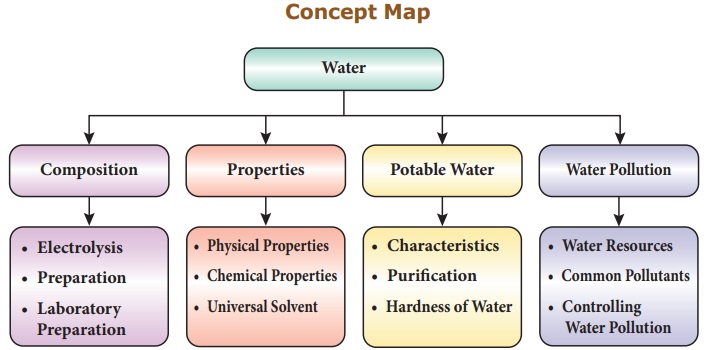Water | Chapter 13 | 8th Science - Points to Remember, Glossary, Concept Map | 8th Science : Chapter 13 : Water
Chapter: 8th Science : Chapter 13 : Water
Points to Remember, Glossary, Concept Map
Points to Remember
• Next to air, water is the most
important resource for our survival.
• Water contains hydrogen and oxygen
as its constituent elements. Its molecular formula is H2O.
• Water is broken down into its
constituent elements by electrolysis. During electrolysis hydrogen and oxygen
are obtained in the ratio 2:1
• Water has a maximum density of 1
g/cc at 4°C. At temperatures below and above 4°C, water has a density of less
than 1 g/cc. This unique property of water helps in the survival of aquatic
life in winters and summers.
• Sea water contains many minerals
and salts dissolved in it and so it is said to be saline.
• Water freezes at 0°C and boils at
100°C.
• Water is a universal solvent as it
can dissolve many substances.
• Water that is used for drinking is
called potable water.
• Water has dissolved gases which
are used by aquatic life for respiration and photosynthesis.
• Hardness of water is due to the
presence of dissolved salts of calcium and magnesium.
• Water pollution is the result of
dumping untreated domestic solid waste and sewage, agricultural waste,
industrial effluents into lakes, rivers, etc.
GLOSSARY
1.
Electrolysis Breaking
down of substances by the passage of electric current.
2.
Potable water Water
used for drinking.
3.
Saline water Water
containing sodium chloride (common salt).
4.
Sterilization Addition
of chemicals to kill the microorganisms present in water.
5.
Eutrophication Over
growth of algae in water bodies due to excessive fertilizers.
6.
Specific heat Amount
of heat that is needed to raise the temperature of a unit mass of
7.
capacity a substance by 1°C.
8.
Latent heat of fusion Amount
of heat energy required by ice to change into water.
9.
Aeration The process in which
air under pressure is blown into filtered water.
10.
Water pollution Addition
of unwanted waste materials to the water.
11.
Domestic sewage Wastewater
that is disposed of from households.
12.
Water conservation Saving
water for the use in future.

Concept Map

REFERENCE BOOKS
1. Water science fair projects –
Madeline Goodstein.
2. Basic chemistry – Karen C. Timberlake
& William Timberlake.
3. Chemistry of water treatment –
Samuel D. Faust Osman M.Aly.
4. Textbook of Environmental Chemistry –
Balarampani.
INTERNET RESOURCES
1. http://www. youtube .
com/watch?v= bZHymnnrSzc
2. http://www.un.org/cyberschoolbus/
waterquiz/waterquiz4/index.asp
3. http : / / w w w. e x pl ai nt
hat stu f f . c om / waterpollution.html
Related Topics